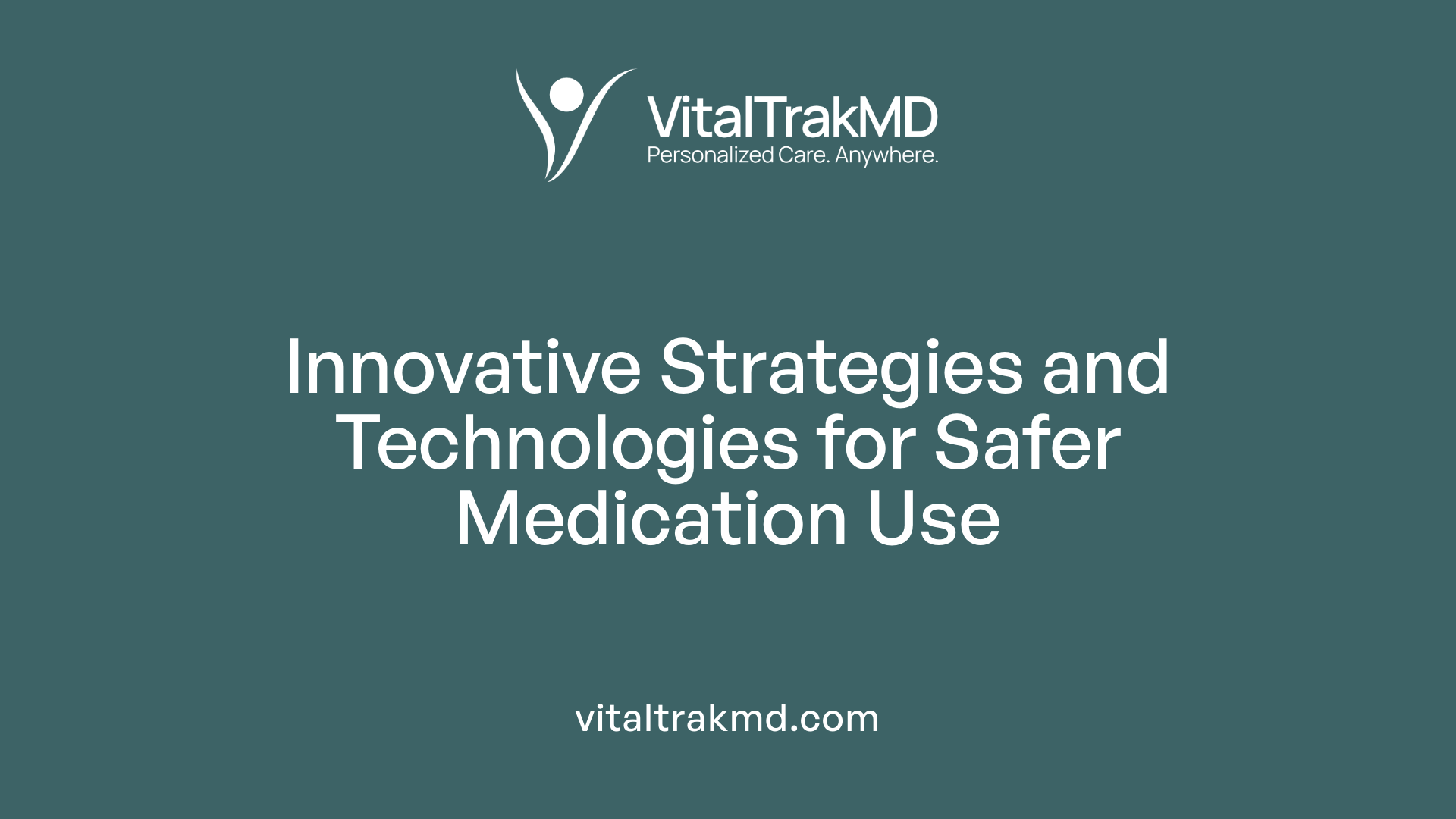Managing Multiple Medications: A Challenge for Aging Adults

Understanding the Challenge of Multiple Medications in Older Adults
Managing multiple medications, often referred to as polypharmacy, is a common yet complex issue faced by aging populations worldwide. Older adults frequently have multiple chronic conditions such as hypertension, diabetes, arthritis, and depression, each requiring specific pharmacological treatments. While these medications are essential for controlling health issues, their concurrent use increases the risk of adverse effects, drug interactions, and non-adherence. This article explores the underlying challenges, implications, and strategies for safe medication management tailored to older adults, ensuring their safety, improving quality of life, and reducing healthcare burdens.
The Scope and Risks of Polypharmacy in Older Adults

What is the prevalence of polypharmacy among older adults?
Polypharmacy, defined as the use of more than five medications simultaneously, is common in the aging population. In high-income countries, studies show that between 40% and 60% of adults aged 60 and older are affected. In some low- and middle-income country communities, rates can be even higher, exceeding 64%. Most older adults, especially those managing multiple chronic conditions like hypertension, diabetes, arthritis, and heart disease, are prescribed several medications to control their health issues. For instance, nearly 89% of adults aged 65 and older are on at least one prescription medication, with over half taking four or more regularly. This high prevalence underscores the widespread nature of polypharmacy and its growing importance in geriatric healthcare.
What are the risks associated with multiple medications?
Using multiple drugs increases the likelihood of adverse drug reactions (ADRs), interactions, and other medication-related problems. Older adults have altered pharmacokinetics and pharmacodynamics due to age-related physiological changes—such as decreased liver and kidney function, increased body fat, and decreased total body water—that influence drug absorption, distribution, metabolism, and elimination. These changes can heighten the risk of toxicity and side effects.
Common complications include oversedation, dizziness, confusion, and falls, which often lead to hospitalizations. Polypharmacy also raises the probability of drug-drug interactions—nearly 40% of prescriptions contain at least one potentially harmful interaction—such as warfarin with NSAIDs, or ACE inhibitors with potassium-sparing diuretics. Additionally, inappropriate polypharmacy can cause drug-disease interactions; for example, NSAIDs may worsen hypertension or heart failure. The phenomenon known as the prescribing cascade occurs when side effects are misinterpreted as new health issues, prompting further prescriptions that may compound risks.
Managing polypharmacy requires careful medication review, considering each drug’s necessity, potential interactions, and monitoring for adverse effects. Effective strategies involve deprescribing unnecessary medications, individualizing therapy, and utilizing clinical tools like the Beers Criteria or STOPP/START guidelines to identify inappropriate prescriptions. Ultimately, reducing unnecessary medications can improve safety, reduce healthcare costs, and enhance quality of life for older adults.
| Aspect | Details | Additional Notes |
|---|---|---|
| Prevalence | 40-60% in high-income countries; over 64% in some LMICs | Reflects aging populations globally |
| Common Conditions | Hypertension, diabetes, arthritis, high cholesterol, depression | Multiple meds for associated comorbidities |
| Impact of Changes | Alters drug processing and increases toxicity risk | Age-related decline in organ function |
| Adverse Reactions | Falls, confusion, gastrointestinal issues | Major cause of hospital admissions |
| Interactions | Drug-drug, drug-disease | Increases morbidity and mortality |
| Management | Regular review, deprescribing, clinical tools | Essential to minimize harm |
How can healthcare providers improve medication safety in older adults?
Effective management of polypharmacy involves a systematic approach. Regular medication reviews by clinicians and pharmacists are vital to identify unnecessary or inappropriate drugs. The use of decision-support tools like the Beers Criteria, STOPP (Screening Tool of Older Persons' Prescriptions), and START (Screening Tool to Alert doctors to Right Treatment) guidelines helps flag high-risk medications and potential interactions.
Deprescribing, the process of tapering or stopping medications that are no longer needed, should be patient-centered and involve interprofessional collaboration. It should consider the patient's health status, life expectancy, and preferences, especially in cases of dementia or chronic illness. Good communication with patients and caregivers is crucial for managing expectations and ensuring adherence during medication adjustments.
Pharmacists can play a pivotal role by conducting comprehensive medication therapy management. They can monitor for drug interactions, ensure appropriate storage and disposal, and recommend cost-effective alternatives. Moreover, adopting technology such as medication synchronization services, electronic health records, and digital reminders can reduce errors and improve adherence.
What strategies are recommended for safer prescribing?
- Medication reconciliation at every healthcare encounter to keep an accurate list of current drugs.
- Use of clinical tools like the Beers Criteria, STOPP, and NO TEARS to identify potentially inappropriate medications.
- Regularly scheduled medication reviews involving a multidisciplinary team, including physicians, pharmacists, and nurses.
- Patient education focused on medication purpose, side effects, and adherence importance.
- Deprescribing protocols that systematically evaluate the need for each drug.
- Shared decision-making with patients and their families to align treatment plans with their goals and preferences.
By integrating these strategies, healthcare systems can significantly reduce the risks associated with polypharmacy and help older adults maintain better health and independence.
Physiological Changes in Aging Affect Drug Handling and Response
How does aging affect medication efficacy and safety?
As individuals age, their bodies undergo various physiological changes that can significantly influence how medications are processed and how they affect the body. These alterations impact both the effectiveness and safety of drug therapies, making medication management in older adults particularly challenging.
Older adults often experience decreased absorption of medications due to factors such as reduced gastric acid production and slower gastrointestinal motility. This can lead to lower bioavailability of certain drugs. Conversely, changes in body composition—specifically increased fat stores and decreased lean mass and total body water—alter the distribution of lipophilic and hydrophilic drugs, respectively. Lipophilic drugs tend to accumulate in fat tissue, prolonging their half-life and potential toxicity.
Metabolism of drugs in the liver is also affected, with reduced hepatic blood flow and liver size leading to decreased hepatic enzyme activity. This diminishes the first-pass metabolism of many drugs, raising their serum concentrations and increasing the risk of toxicity. Moreover, renal function declines with age, even in the absence of overt kidney disease, impairing drug excretion.
These pharmacokinetic changes increase the susceptibility of older adults to adverse drug effects, particularly when multiple medications—polypharmacy—are involved. Increased drug sensitivity, especially to central nervous system and cardiovascular drugs, further amplifies safety concerns.
Overall, these age-related alterations necessitate careful dose adjustments, vigilant monitoring, and individualized treatment plans to ensure medication efficacy while minimizing risks.
What strategies can healthcare providers use to reduce polypharmacy?
Reducing polypharmacy involves systematic and patient-centered approaches. Regular medication reviews are fundamental, enabling healthcare providers to assess whether each drug remains necessary and appropriate for the patient’s current health status.
Utilizing evidence-based tools enhances decision-making. The Beers Criteria, for example, highlights medications that are potentially inappropriate for older adults. The STOPP (Screening Tool of Older Person’s Prescriptions) and START (Screening Tool to Alert doctors to Right Treatment) criteria assist clinicians in identifying dangerous drug combinations and opportunities for de-prescribing.
Implementing deprescribing protocols involves carefully tapering or stopping unnecessary medications while monitoring the patient for any withdrawal effects or disease recurrence. This process should be performed gradually and collaboratively, with good communication among healthcare providers, patients, and caregivers.
Deprescribing is complemented by medication reconciliation during care transitions—such as hospital discharge—and by maintaining comprehensive, updated medication lists. Electronic health records can facilitate this process, reducing redundant or duplicate prescriptions.
Collaboration among healthcare professionals, notably pharmacists, plays a significant role. Pharmacists can identify drug interactions, recommend alternative therapies, and counsel patients on medication adherence. Engaging patients in shared decision-making, explaining the reasons for deprescribing, and considering their preferences improve acceptance and adherence.
Overall, these strategies aim to optimize medication regimens, reduce unnecessary drug use, prevent adverse events, and improve health outcomes for older adults.
More insights on managing medications in older adults
| Aspect | Description | Impact on Practice |
|---|---|---|
| Age-related changes | Decreased gastric acid, hepatic metabolism, renal function; body composition changes | Necessitate dose adjustment, monitoring |
| High-risk medication classes | Anticholinergics, sedatives, NSAIDs, cardiovascular drugs, narcotics | Require careful selection and monitoring |
| Management tools | Beers Criteria, STOPP/START, NO TEARS, DDI, ACB, DBI | Aid in identifying inappropriate medications |
| Deprescribing approaches | Systematic review, gradual tapering, shared decision-making | Reduce medication burden, prevent ADEs |
| Barriers to deprescribing | Patient resistance, clinician training gaps, healthcare system fragmentation | Need for tailored, multidisciplinary interventions |
| Emerging technologies | Telemedicine, AI, electronic prescribing systems | Support personalized, safer medication management |
Understanding how aging affects drug handling and response underscores the importance of vigilant, personalized medication management in older adults. This approach minimizes risks associated with pharmacotherapy, enhances efficacy, and promotes overall health and well-being among aging populations.
Challenges and Barriers in Managing Medications for Older Adults
What are the common challenges in medication management faced by older adults?
Managing medications in older adults presents a range of difficulties that can impact safety and treatment effectiveness. A significant issue is the prevalence of polypharmacy; over half of seniors are prescribed five or more medications daily to manage multiple chronic health conditions. This complexity increases the risk of adverse drug reactions, drug interactions, and medication errors.
Cognitive decline, including memory impairments associated with aging and dementia, hampers patients' ability to remember dosing schedules, leading to missed or incorrectly timed doses. Physical limitations such as arthritis, tremors, or impaired vision can make handling medication bottles, opening packages, or reading small labels difficult.
Adherence issues are also common, often stemming from lack of understanding of medication instructions, side effect fears, or unintentional non-compliance. These challenges are compounded by inadequate communication between healthcare providers and patients, and barriers like transport issues, long wait times, and limited access to pharmacies or clinic services.
Overall, these factors contribute to increased hospitalization, morbidity, and diminished quality of life, emphasizing the importance of personalized strategies to simplify medication regimens, improve communication, and utilize supportive tools.
What are the principles of safe medication management in seniors?
Ensuring medication safety in older populations involves systematic, cautious approaches. Central to this are the "five rights"—administering the right patient, drug, dose, route, and time. Healthcare providers must verify patient identities meticulously, often using multiple identifiers to avoid errors.
Labels should be carefully read, and double-checking practices or barcode scanning should be used when available to prevent incorrect medication administration. Proper organizational practices include ensuring adequate staffing, adequate lighting, and designing user-friendly medication administration devices.
Staff training regarding medication safety protocols is essential. Nurses play a pivotal role by acting as the last checkpoint for medication accuracy before dispensing. Implementing antimicrobial stewardship and infection control measures further reduces risks associated with medications, such as resistance or secondary infections.
System-level safety measures, like medication reconciliation, clear documentation, and routine audits, complement bedside practices. These combined principles foster a safer environment, minimizing medication errors and adverse events among older adults.
What systemic healthcare obstacles hinder effective medication management?
Various systemic issues can hinder optimal medication management for seniors. Fragmented healthcare delivery means multiple providers may independently prescribe medications without comprehensive coordination, increasing the risk of redundancy and interactions.
Limited healthcare provider training on geriatric pharmacology can lead to inappropriate prescribing, with underutilization of tools like the Beers Criteria or STOPP/START guidelines. Additionally, healthcare systems in low- and middle-income countries (LMICs) face challenges such as weak regulatory oversight, inconsistent drug supply, and low health literacy among patients.
Cultural beliefs favoring traditional medicines, reliance on over-the-counter remedies, and lack of access to healthcare resources create barriers to proper medication use. economic constraints, such as high medication costs, prevent consistent adherence.
Furthermore, inefficient medication reconciliation processes, inadequate electronic health record systems, and workforce shortages contribute to these barriers. Addressing these systemic obstacles requires policy reform, improved provider education, integrated care models, and leveraging technology, such as telemedicine and AI-driven decision support, to enhance medication safety and management.
Practical Tools and Strategies for Enhancing Medication Safety

What strategies can healthcare providers use to reduce polypharmacy?
Healthcare providers play a crucial role in minimizing the risks associated with polypharmacy among older adults. One fundamental approach is conducting thorough, regular medication reviews. This process involves systematically evaluating each medication for its current necessity, safety, and relevance to the patient’s health status.
To support these reviews, clinicians utilize evidence-based tools such as the Beers Criteria, which lists medications that should be avoided or used cautiously in older adults. The STOPP (Screening Tool of Older Person’s Prescriptions) and START (Screening Tool to Alert doctors to Right Treatment) criteria help identify potentially inappropriate medications and suggest necessary treatments that might be omitted.
Implementing deprescribing protocols is also essential. This involves gradually tapering or stopping medications that are no longer beneficial or may cause harm, with close monitoring for withdrawal symptoms or health deterioration. A systematic approach ensures patient safety and improves quality of life.
Collaboration among multidisciplinary teams—including physicians, pharmacists, and nurses—is vital for comprehensive medication management. Pharmacists, in particular, can provide medication therapy management (MTM) services, reviewing medication lists for redundancies and interactions.
Effective medication reconciliation during transitions of care—such as hospital admissions and discharges—prevents unnecessary duplication or omission of drugs. Electronic health records facilitate accurate documentation and communication, reducing errors.
Engaging patients in shared decision-making by explaining the purpose and potential risks of medications helps improve adherence and empowers them to participate actively in their treatment plan. Overall, these strategies help optimize medication regimens and diminish the burden of polypharmacy.
What educational approaches and tools support medication adherence?
Enhancing medication adherence among older adults requires tailored educational strategies that address common barriers such as memory issues, low health literacy, and physical limitations. Clear, straightforward communication is fundamental. Healthcare providers should use simple language, visual aids, and written leaflets that outline medication purpose, dosing schedules, and possible side effects.
Tools like pill organizers and medication reminder applications—such as MediSafe, MyTherapy, or PillPack—aid in organizing doses and preventing missed or double dosing. Color-coded containers can also assist with distinguishing medications, especially for individuals with visual impairments.
Involving caregivers—family members, friends, or professional aides—in medication management further supports adherence. Caregivers can provide reminders, observe medication intake, and alert healthcare providers to concerns or side effects.
Regularly reviewing medications with healthcare providers allows patients to understand the importance of each drug, discuss side effects, and clarify doubts, fostering trust and adherence. Tailoring education to the patient's cognitive and sensory abilities—such as using large print or talking aid devices—ensures they are active participants rather than passive recipients.
Ultimately, combining verbal instructions, written information, practical aids, and active engagement creates a supportive environment that promotes safe and consistent medication use, leading to better health outcomes.
Utilizing technology
Technology offers innovative solutions to improve medication safety and adherence. Smartphone apps like MediSafe, MyTherapy, and Care24 provide reminders for medication timings, track doses taken, and alert users to refills. These tools help reduce forgetfulness and reinforce routine, especially in complex medication regimens.
Electronic health records (EHRs) enhance medication reconciliation by providing comprehensive medication lists accessible across healthcare settings, reducing errors related to incomplete data.
Artificial intelligence and telemedicine platforms can facilitate personalized medication management consultations. AI algorithms analyze patient data to suggest optimal regimens, flag potential drug interactions, and recommend deprescribing opportunities.
Advanced drug-dispensing systems, such as synchronized pill dispensers and robotic medication management devices, offer further support in ensuring accurate administration.
However, adoption of technological solutions requires consideration of the patient's digital literacy and access. Tailoring technological interventions to the elderly’s comfort level and providing education on their use is essential.
In sum, integrating digital tools with traditional practices can significantly boost medication safety and adherence, leading to fewer adverse events and better quality of life for older adults.
The Role of Healthcare Professionals and Systems in Ensuring Safe Use of Multiple Medications

What strategies can healthcare providers use to reduce polypharmacy?
Healthcare providers play a crucial role in managing polypharmacy among older adults. One of the most effective strategies is conducting comprehensive medication reviews regularly. These reviews assess whether each medication is necessary, safe, and appropriate given the patient’s current health status. Utilizing evidence-based tools such as the Beers Criteria, STOPP/START guidelines, and the Medication Appropriateness Index assists clinicians in identifying inappropriate or redundant drugs that can be discontinued.
Deprescribing protocols are essential, involving systematic evaluation, gradual dose reduction, and close monitoring to prevent withdrawal effects or symptom relapse. Collaboration between physicians, pharmacists, and other healthcare professionals ensures a holistic approach. Engaging patients and their caregivers through shared decision-making and education empowers them to understand their medication regimens and participate actively in deprescribing decisions.
Medication reconciliation during care transitions—such as hospital discharge or moving between healthcare settings—helps to identify and resolve discrepancies, further reducing unnecessary medications. The use of electronic health records enhances accuracy and facilitates ongoing monitoring to optimize therapy and minimize polypharmacy-related risks.
How can system-wide approaches improve medication safety for older adults?
Improving medication safety at a system level requires implementing standardized protocols, checklists, and clinical decision support systems integrated into healthcare workflows. Such tools provide evidence-based prescribing guidance tailored to older populations, decreasing the likelihood of inappropriate medication use.
Interprofessional care models are fundamental, bringing together physicians, pharmacists, nurses, and geriatric specialists to conduct comprehensive assessments and develop coordinated management plans. Training healthcare providers in deprescribing practices, age-specific medication adjustments, and effective communication enhances overall quality of care.
Investments in electronic health records (EHRs), medication reconciliation processes, and patient-centered technologies, such as telemedicine platforms and mobile medication management apps, support continuous monitoring and adherence. Policy measures promoting regular review schedules, incentivizing safe prescribing, and expanding access to geriatric expertise create an environment conducive to minimizing medication-related risks.
System-wide strategies centralize efforts to streamline medication management, reduce errors, and improve health outcomes for older adults, ultimately fostering safer pharmacotherapy.
What are the ethical and practical considerations in deprescribing for older adults, especially those with dementia or limited life expectancy?
Deprescribing in older adults with conditions like dementia or limited life expectancy involves nuanced ethical and practical considerations. Ethical principles emphasize respecting patient autonomy and ensuring that medical decisions align with their values and care goals. Clinicians must balance the potential benefits—such as symptom relief, improved safety, and quality of life—against risks like withdrawal effects or unintended deterioration.
Practically, deprescribing requires effective communication with caregivers and family members who often manage day-to-day medication adherence. Cognitive impairment complicates medication management, necessitating simplified regimens and careful monitoring.
Healthcare providers must evaluate each medication’s risk-benefit profile contextually, focusing on improving comfort and functionality without causing discomfort or hastening decline. Transparency with patients and families about the goals of care and the rationale for lowering medication burdens is vital.
Ultimately, deprescribing should be patient-centered, ethically sound, and tailored to individual circumstances, ensuring that the process respects dignity, alleviates suffering, and aligns with the patient's preferences and life expectancy.
Optimizing Medication Use for Healthy Aging
Managing multiple medications in older adults is a delicate balance that requires comprehensive assessment, vigilant monitoring, and collaborative efforts among healthcare providers, patients, and caregivers. By implementing systematic reviews, evidence-based guidelines, and leveraging technological tools, healthcare systems can reduce the risks associated with polypharmacy. Education, communication, and personalized care strategies empower seniors to participate actively in their medication management, improving adherence and safety. As research advances and practices evolve, focusing on deprescribing and tailored interventions promises to enhance quality of life and health outcomes for aging populations, ensuring that medication management remains a pillar of safe, effective, and compassionate geriatric care.
References
- Strategies to Reduce Polypharmacy in Older Adults - StatPearls - NCBI
- The dangers of polypharmacy and the case for deprescribing in ...
- Polypharmacy in Adults 60 and Older | Johns Hopkins Medicine
- Tackling Polypharmacy in Geriatric Patients: Is Increasing ...
- Managing polypharmacy through medication review tools – pros ...
- Five Tips for Addressing Polypharmacy in Older Adults
- Managing medications for aging parents - Mayo Clinic Health System
- How to Manage Multiple Medications as a Senior? - Local MD NYC
- Managing Medications as We Age: Tips and Strategies for Older ...
- Medication use problems and factors affecting older adults in ...
Recent articles
Want to Feel Better and Live Healthier?
Join hundreds of patients taking control of their health with personalized care that fits their life – not the other way around.
Rated 4.8/5 by 32+ customers







